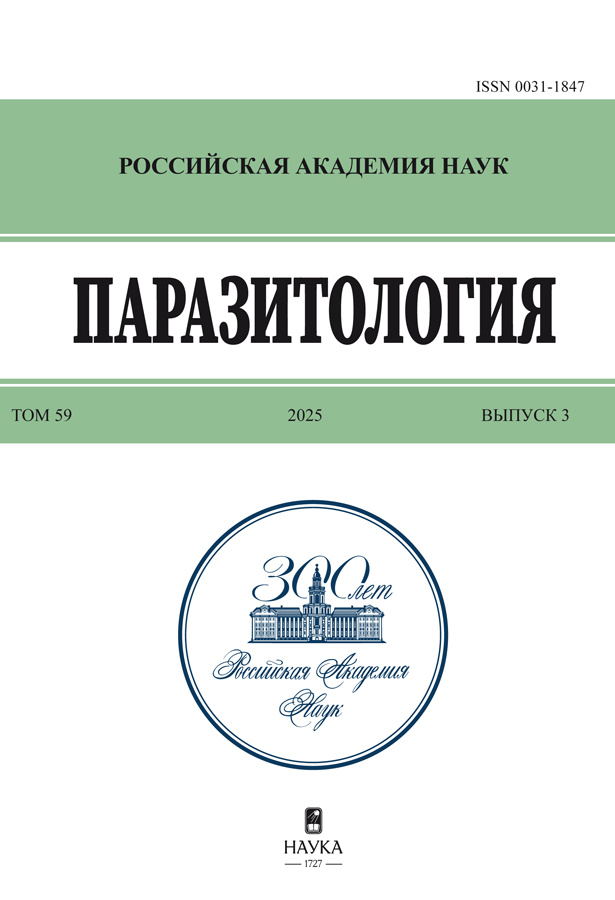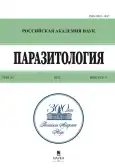Том 59, № 3 (2025)
Статьи
Виды блох (Siphonaptera) – переносчиков чумы в природных очагах мира (часть 1)
Аннотация
В обзоре приведены сведения о типах ареалов и распространении, паразито-хозяинных связях 94 видов блох, известных как переносчики чумы в природных очагах в различных областях мира. В частности, рассмотрены 1) 37 видов семейств Pulicidae, Tungidae, Rhopalopsyllidae, Vermipsyllidae и Coptopsyllidae, 2) 53 вида семейств Hystrichopsyllidae s. l., Chimaeropsyllidae и Stephanocircidae, 3) четыре вида сем. Stivaliidae.
 179–214
179–214


О продолжительности жизни самцов Aedes (Ochlerotatus) communis (de Geer) и A. (O.) cantans (Meigen) (Diptera, Culicidae), выращенных из эмбрионов в лабораторных условиях
Аннотация
Проведена сравнительная оценка дожития у имаго самцов комаров Aedes (Ochlerotatus) communis (de Geer) и A. (O.) cantans (Meigen), вместе развивавшихся из эмбрионов в лабораторных условиях. Яйца (эмбрионы) собраны в природе из-под снега, развитие до выплода имаго проходило при температуре воды 21–22°С. Имаго содержали в контейнерах с доступом к воде и сахарозе; средняя температура воздуха составляла 22.4°С, влажность – выше 50%, режим освещения – естественный. Самцы A. communis выплаживались первыми и погибали, как правило, раньше, чем самцы A. cantans, считая от времени выплода для каждой отдельной особи. Медианная продолжительность жизни в выборках самцов A. communis и A. cantans составила 7.5 и 20 сут соответственно. Среди самцов, выращенных в лаборатории из эмбрионов, самцы A. cantans более удобны для длительного лабораторного содержания, чем самцы A. communis. Результаты пилотных статистических сравнений с данными, полученными в 2022–2023 гг., позволяют предварительно заключить, что самцы A. cantans, выращенные из эмбрионов, не уступают по своей жизнеспособности самцам того же вида, проходившим бóльшую часть своего развития в природе, и что жизнеспособность самцов A. cantans, выращенных из разных выборок эмбрионов, может различаться.
 215–223
215–223


Ужеобразные змеи как паратенические хозяева – ловушки нематоды Spiroxys contortus (Chromadorea, Gnathostomatidae) в Нижнем Поволжье
Аннотация
Материалом для данной работы послужили сборы личинок Spiroxys contortus (Rudolphi, 1819) от ужеобразных змей фауны Нижнего Поволжья в 2020 г. Всего собрано 28 экз. личинок S. contortus от обыкновенного Natrix natrix (Linnaeus, 1758) и водяного Natrix tessellata (Laurenti, 1768) ужей. Паразит впервые зарегистрирован нами у обыкновенного ужа N. natrix фауны России. Приводятся морфологическая и морфометрическая характеристики личинок S. contortus от обыкновенного и водяного ужей.
 224–230
224–230


Длинные некодирующие РНК трематоды Himasthla elongata (Mehlis, 1831) (Trematoda, Himasthlidae)
Аннотация
Молекулярные механизмы, регулирующие жизненный цикл трематод, на сегодняшний день остаются малоизученными. Предполагается, что в этой регуляции задействована некодирующая часть генома, а именно длинные некодирующие РНК (lncRNAs) и повторы. В этой работе мы впервые идентифицировали lncRNAs трематоды Himasthla elongata (Mehlis, 1831) Dietz, 1909 на основе анализа транскриптома с учетом гомологии с повторами. Примерно половина выявленных lncRNAs несет в себе участки транспозонов, занимающих 57.5% генома. Экспрессия ряда lncRNAs была подтверждена на стадиях редии, церкарии и метацеркарии. Полученные данные создают основу для дальнейшего изучения роли мобильных элементов в формировании регуляторных РНК и в эволюции механизмов регуляции транскрипции у трематод.
 231-251
231-251


Долговременная динамика гельминтофауны моевок (Rissa tridactyla L., 1758) на архипелаге Семь островов (Баренцево море)
Аннотация
Прослежена динамика гельминтофауны взрослых моевок (Rissa tridactyla L., 1758) в гнездовых колониях на о. Харлов (архипелаг Семь Островов, Баренцево море, Кандалакшский государственный природный заповедник). Выявлена тенденция неуклонного снижения видового разнообразия паразитов птиц. Однако значения количественных показателей инвазии у основных видов гельминтофауны моевок (цестод Alcataenia larina (Krabbe, 1869) и Tetrabothrius (Oriana) erostris (Lönnberg, 1899) Baylis, 1926, а также нематоды Paracuaria adunca (Creplin, 1846) Anderson et Wong, 1981 за три этапа исследований (в 1940–1941, 1991 и 2024 г.) почти не претерпели статистически значимых изменений. Полученные результаты, вероятно, объясняются тем, что климатические флуктуации и антропогенный пресс могли вызвать определенную перестройку паразито-хозяинных связей, но не нарушили структуру и устойчивость основных паразитарных систем. По результатам анализа содержимого желудков изучены особенности питания птиц в различные периоды. Проанализированы особенности и вероятные причины географического распространения и встречаемости обнаруженных гельминтов, проведена комплексная оценка зараженности моевок в прибрежье Мурмана.
 252-264
252-264










